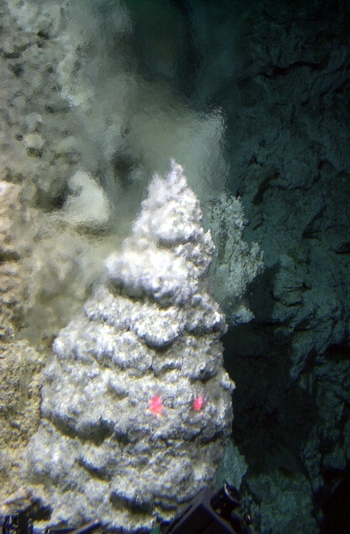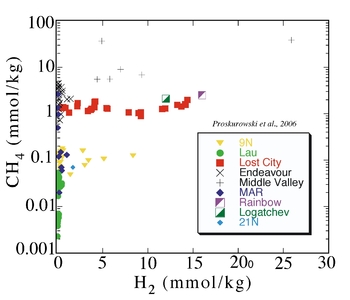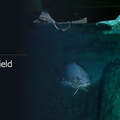
This small Beehive structure vents the highest temperature (91°C), highest pH fluids (11) at L ...

Carbonate chimney venting 91°C, pH 11 fluids

Lost City vent fluid H2 concentrations are 0.5 to 14.4 mmol/kg [Proskurowski et al., 20 ...

Methane and Hydrogen At Lost City
Beneath the Lost City system, serpentinization reactions in the subsurface produce Ca-enriched (up to 30 mmol/kg ), high pH fluids (pH = 9-11) that have temperatures between 40°C to 91°C. The purest vent fluids contain little if any magnesium and are highly depleted in metals. Serpentinization reaction within the Atlantis Massif creates reducing environments marked by high H2 concentrations, which are well suited to abiotic hydrocarbon production. The general reaction is
6[(Mg1.5Fe0.5)SiO4] + 7H2O ⇒ 3[(Mg3Si2O5(OH)4] + Fe3O4 + H2
olivine water serpentine magnetite hydrogen
At Lost City, vent fluid H2 concentrations are 0.5 to 14.4 mmol/kg [Proskurowski et al., 2006], which are greater than the highest H2 concentrations in fluids from basaltic environments that are unperturbed by magmatic and eruptive events [Kelley et al., 2002; Lilley et al., 2003]. These highly reducing conditions lead to elevated concentrations of CH4 (1-2 mmol/kg) in the Lost City fluids [Proskurowski et al., 2006]. The highest H2 values approach those at Rainbow and surpass those at Logatchev ; both are peridotite- and gabbro–hosted hydrothermal systems on the Mid-Atlantic Ridge. However, Rainbow and Logatchev vent fluids differ from those at the LCHF in that they have elevated CO2 and dissolved metals, low pH, and temperatures of 350°-360°C: characteristics typical of black smoker vents hosted by basalts. In contrast, the moderate-temperature, high-pH, sulfate-bearing fluids at the LCHF are highly depleted in CO2 and dissolved metals [Kelley et al., 2005; Ludwig et al., 2006; Proskurowski et al., 2006; 2008].
Some of the most compelling evidence for abiogenic synthesis of hydrocarbons in natural systems comes from our integrated investigation of Lost City. Concentrations and stable and radiocarbon isotopic analyses of hydrocarbons dissolved in H2-rich Lost City fluids provide compelling evidence that low molecular weight hydrocarbons are formed by Fisher-Tropsch type (FFT) reactions in the basement rocks [Proskurowski et al., 2008].
Fluids from LCHF contain higher concentrations of formate (36-158 μmol/kg) and acetate (1-35 μmol/kg) than any other non-sedimented hydrothermal system studied to date [Lang et al., 2010]. Several lines of evidence support the abiotic formation of formate at Lost City including its isotopic composition, its rapid equilibration with CO2 in laboratory experiments, and the ratio of formate to total dissolved organic carbon [Lang et al., 2010]. Formate is the second most prevalent carbon species in Lost City fluids and may provide the necessary carbon source to local microbial communities in the face of low dissolved inorganic carbon concentrations [<1 to 26 µM; Proskurowski et al., 2008].




